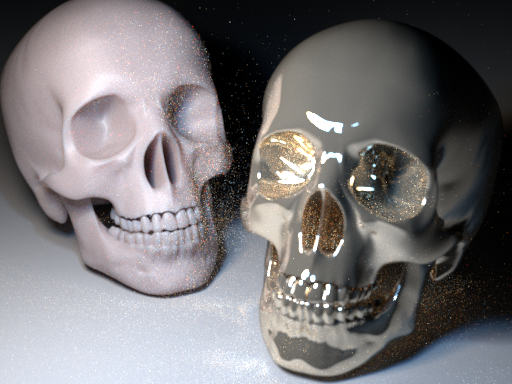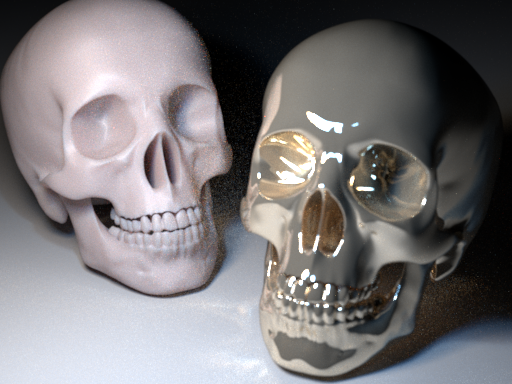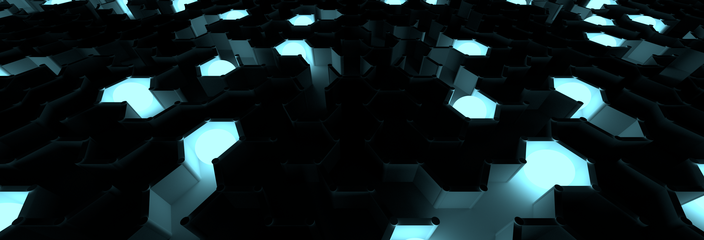PxrVCM
PxrVCM
This is a core final-quality integrator in the RIS system. It combines bidirectional path tracing with progressive photon mapping (also known as vertex merging). Each of these techniques brings the ability to capture a certain range of light transport paths more efficiently than a pure forward path tracing algorithm:
- Bidirectional path tracing can converge faster than forward path tracing for interior scenes or scenes with significant indirect illumination. In particular, when forward path tracing can't easily find an indirect path to the dominant light source, bidirectional path tracing can help especially if the dominant light source is "one bounce" away from illuminating the scene. It also offers the possibility of faster indirect lighting in general because bidirectional path tracing can make multiple connections between a light path and a eye path and reuse shader evaluations. (A forward path tracer has to run a shader at every bounce, and therefore cannot reuse shader evaluations.) Note that this benefit is more pronounced if your pattern evaluations are expensive; Bxdfs without pattern inputs will not benefit from this.
- Progressive photon mapping converges faster for specular-diffuse-specular lighting (reflections or refractions of caustics), most especially when dealing with relatively small light sources.
These sampling techniques are combined along with direct lighting (connecting an eye vertex directly to a light source) using multiple importance sampling in a way such that the combined algorithm is substantially more robust and converges faster across a wide range of shots than simply using any one technique by itself.
The PxrVCM integrator in its default mode of operation enables all of these techniques, but should the need present itself, can also operate as a pure bidirectional path tracer, a pure unidirectional path tracer, or even use pure progressive photon mapping by disabling merging and/or connecting via the mergePaths and connectPaths parameters.

Rendered using only forward path tracing (mergePaths=0, connectPaths=0), 512 samples per pixel. Caustics are very noisy, and many fireflies are present due to the difficult to integrate lighting caused by the highly specular metallic skull.

Rendered using the full vertex connecting and merging algorithm (mergePaths=1, connectPaths=1), 512 samples per pixel. Fireflies are almost nonexistent, and caustics are much better resolved.
For direct illumination, PxrVCM looks at the values of the numLightSamples and numBxdfSamples parameters in order to determine the number of light vs. Bxdf direct illumination samples. For lowest noise numLightSamples and numBxdfSamples should be set to the same value. Direct illumination sample reduction at deeper ray depth and/or lower throughput is enabled by default and the scheme used can be controlled with the reduceDirectSamples parameter.
PxrVCM fully supports multiple scattering of volumes. Bidirectional path tracing in particular is well suited for multiple scattering of volumes. PxrVCM does not currently support volumetric photons; as a result, effects such as volumetric caustics may be slow to converge.
There are several important differences to note between this integrator and PxrPathTracer:
- PxrVCM does not support the ability to turn off caustic light paths. In order to match the result from PxrVCM, images generated by PxrPathTracer should be rendered with allowCaustics set to 1.
- PxrVCM is less forgiving for having different numLightSamples than numBxdfSamples than PxrPathTracer. They should (nearly) always be be set to the same value -- otherwise unnecessary noise can appear.
- Due to the nature of bidirectional path tracing, PxrVCM does not expose any controls over the indirect ray sample count; all vertices generate at most one indirect ray.
- Rendering a crop window may result in a different quality render than a full frame render. This is because light paths are generated per-pixel and stored in a photon map. When rendering a smaller region, fewer photons are saved as a side-effect. In theory all the light paths could be generated but the impact on performance would begin to erode the benefit of rendering a small region of the final image.

For more information, please consult the relevant papers:
- Iliyan Georgiev, Jaroslav Křivánek, Tomáš Davidovič and Philipp Slusallek. Light Transport Simulation with Vertex Connection and Merging. ACM Transactions on Graphics (SIGGRAPH Asia 2012)
- Toshiya Hachisuka, Jacopo Pantaleoni, and Henrik Wann Jensen. A Path Space Extension for Robust Light Transport Simulation. ACM Transactions on Graphics (SIGGRAPH Asia 2012)
Parameters
mergePaths
Controls whether "vertex merging" is employed. Vertex merging enables a variant of progressive photon mapping, which converges faster than path tracing for specular-diffuse-specular (caustic) lighting. Enabling vertex merging is generally recommended but does result in additional time and memory overhead for photons, and in scenes with little specular-diffuse-specular transport, may be unnecessary. Set this parameter to either 0 (vertex merging off) or 1 (vertex merging on). By default, vertex merging is enabled. Note that photon generation requires the incremental flag be turned on for the Hider; the photons generated in the current increment are used as the photon map for the next increment.
With no vertex merging, but with path connection enabled, VCM acts only as a bidirectional path tracer.
connectPaths
Controls whether "vertex connection" is employed. The power of bidirectional path tracing over forward path tracing is in the ability to repeatedly reuse indirect contributions down the full combined path by making repeated connections between the eye and light paths, leading to faster convergence for interior scenes with significant indirect illumination.
With both vertex merging and vertex connection disabled, VCM acts only as a forward, unidirectional path tracer (no light paths are generated).
With vertex merging enabled and vertex connection disabled, VCM implements a variant of bidirectional progressive photon mapping; this mode is generally not recommended as it does not make direct connections between the eye vertex and the light, and as a consequence usually has slower convergence for direct lighting than all other modes.
Set this parameter to either 0 (vertex connection off) or 1 (vertex connection on). By default, vertex connection is enabled
mergeRadiusScale
Specifies a scaling factor for the radius used in vertex merging. By default, the VCM integrator computes an automatic radius for vertex merging, based on ray differentials computed along the eye path. This parameter specifies an additional scaling factor to be applied to the default computed radius. Increasing the scaling factor will blur the influence of a photon over a wider region, which may be helpful in reducing noisy caustics. However, increasing the radius will also slow down merging and increase the initial bias of progressive photon mapping, requiring more iterations to arrive at a bias-free result. The default value of 5.0 significantly reduces noise at the cost of some initial bias which decreases with more samples. Should these bias artifacts be objectionable when using low numbers of samples, decreasing the mergeRadiusScale will reduce these artifacts at the expense of more noise.
timeRadius
Specifies the maximum difference in time, measured as a fraction of the shutter interval, over which photons are merged. By default, the timeRadius is 1.0: eye vertices can be merged with photons emitted at any time. This may lead to inaccurate results (i.e. smearing in time) for caustics from moving objects. Setting the timeRadius to a smaller value tightens the search radius in time for mergeable photons, leading to better results for motion blurred caustics, at the cost of static objects requiring more photons in order to resolve caustics.
maxPathLength
Controls the maximum length of a combined light and eye path, including the connection rays. For example, a value of 4 will permit up to 3 bounces of global illumination. A value of 1 for this parameter will allow direct illumination only, which means that no light paths will be generated (since eye path vertices are always directly connected to the light source). The default value of this parameter is 10.
numLightSamples
Controls the number of light samples for direct illumination per vertex on the eye path. The default is 1. For lowest noise numLightSamples and numBxdfSamples should be set to the same value.
numBxdfSamples
Controls the number of Bxdf samples for direct illumination per vertex on the eye path. The default is 1. For lowest noise numLightSamples and numBxdfSamples should be set to the same value.
rouletteDepth
Controls the path length at which the integrator begins performing Russian roulette in order to reduce overall path length. The default is 4. Note that Russian roulette is applied separately to both the eye and the light paths.
rouletteThreshold
Controls the path throughput threshold below which to begin performing Russian roulette. The default is 0.2. Increasing the threshold will lead to a reduction in path length, which will lead to an overall increase in speed at the expense of higher noise.
clampDepth
If a value for the clampLuminance parameter is specified, then clampDepth controls the ray depth at which to begin clamping based on the per-ray luminance. For example, setting this parameter to 2 and also specifying a value of 4 for clampLuminance will ensure that the luminance of each ray's contribution is no more than 4 for all indirect illumination, without affecting or clamping the direct illumination. The default is 2.
clampLuminance
By default the PxrVCM integrator clamps the luminance computed by any technique on any vertex to be at most 10.0. However, it is possible to change this behavior by specifying a different value for the clampLuminance parameter. Specifying a relatively low value for the clampLuminance parameter (for example, between 2 and 20) can greatly speed up convergence. In some cases, indirect illumination lights paths may be noticeably dimmer due to clamping; this may be an acceptable trade-off in certain cases. Setting this parameter to a very large number (such as 1e30) will effectively disable all clamping. The default is 10.0.
Standard AOVs
On top of regular LPE-based AOVs, this integrator ouptuts a number of standard AOVs typically used by compositors.
| Declaration | Contents | Channels |
|---|---|---|
| color __Pworld | P in world-space | __Pworld.r : x component
__Pworld.g : y component
__Pworld.b : z component
|
| color __Nworld | Nn in world-space | __Nworld.r : x component
__Nworld.g : y component
__Nworld.b : z component
|
| color __depth | Multi-purpose AOV | __depth.r : depth from camera in world-space
__depth.g : height in world-space
__depth.b : geometric facing ratio : abs(Nn.V)
|
| color __st | Texture coords | __st.x : s
__st.y : t
__st.z : 0.0
|
| color __Pref | Reference Position primvar (if available) | __Pref.r : x component
__Pref.g : y component
__Pref.b : z component
|
| color __Nref | Reference Normal primvar (if available) | __Nref.r : x component
__Nref.g : y component
__Nref.b : z component
|
| color __WPref | Reference World Position primvar (if available) | __WPref.r : x component
__WPref.g : y component
__WPref.b : z component
|
| color __WNref | Reference World Normal primvar (if available) | __WNref.r : x component
__WNref.g : y component
__WNref.b : z component
|
